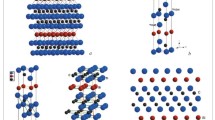Abstract
Sintering diagrams, which determine the dominating mechanism of powder sintering at a given temperature, the size of powder grains, and the neck between the grains, may be used to explain the experiments on sintering and solve some practical problems concerning the sintering of metals and ceramics. In this work we have built sintering diagrams for titanium carbide powders of various dispersities. Using such diagrams, we have established that the dominating mechanisms of sintering titanium carbide micro- and nanopowders are the surface and grain-boundary diffusion of substance to the neck between the particles. It is found that the contribution of sintering basic mechanisms in the case of titanium carbide does not depend on the dispersity of powders.
Similar content being viewed by others
References
M. F. Ashby, “A First Report on Sintering Diagrams,” Acta Metall. 22(3), 275–289 (1974).
M. I. Alymov, A. A. Pimenova, and E. N. Pirogov, Fiz. Khim. Obrab. Mater., No. 2, 69–72 (1999).
S. I. Averin and M. I. Alymov, “Dominant Diffusion Mechanisms in Sintering of Nickel Powders,” in Proceedings of the Third All-Russia Conference on Nanomaterials NANO 2009, Yekaterinburg, 2009 (Ural Izd., Yekaterinburg, 2009), pp. 403–404.
B. B. Panigrahi, M. M. Godkhindi, K. Das, P. G. Mukunda, V. V. Dabhade, and P. Ramakrishnan, “Sintering Mechanisms of Attrition Milled Titanium Nano Powder,” J. Mater. Res. 20(4), 827–836 (2005).
S. S. Kiparisov, Yu. V. Levinskii, and A. P. Petrov, Titanium Carbide: Fabrication, Properties, and Application(Metallurgiya, Moscow, 1987) [in Russian].
G. V. Samsonov and I. M. Vinnitskii, Refractory Compounds (Metallurgiya, Moscow, 1976) [in Russian].
H. J. Frost and M. F. Ashby, Deformation-Mechanism Maps. The Plasticity and Creep of Metals and Ceramics(Pergamon Press, New York, 1982).
L. M. Liu, S. Q. Wang, and H. Q. Ye, “Adhesion of metal-carbide/nitride interfaces: Al/TiC and Al/TiN,” J. Phys.: Condens. Matter, 15, 8103 (2003).
M. I. Alymov, V. A. Zelenskii, S. S. Bedov, and S. A. Tikhomirov, “Tungsten Powder Sintering Mechanisms” in Proceedings of the First International Conference “Deformation and Destruction of Materials (IMET im. A.A. Baikova RAN, Moscow, 2006).
M. I. Alymov, V. A. Zelenskii, A. B. Ankudinov, and V. S. Shustov, “Porosity of a Porous Material Made of Titanium Carbide Powder,” Fiz. Khim. Obrab. Mater., No. 2, 55–58 (2009).
M. I. Alymov, V. S. Shustov, A. B. Ankudinov, and V. A. Zelenskii, “Fabrication of a Porous Tube Made of Titanium Carbide Powder,” Perspekt. Mater., No. 1, 94–96 (2011).
M. I. Alymov, V. S. Shustov, A. V. Kasimtsev, V. V. Zhigunov, A. B. Ankudinov, and V. A. Zelenskii, “Synthesis of Titanium Carbide Nanopowders and Fabrication of Porous Materials Based on Them,” Ross. Nanotekhnol., Nos. 1–2, 84–89 (2011).
Author information
Authors and Affiliations
Corresponding author
Additional information
Original Russian Text © V.S. Shustov, I.A. Zaletova, S.I. Averin, V.A. Zelenskii, A.B. Ankudinov, M.I. Alymov, 2012, published in Rossiiskie Nanotekhnologii, 2012, Vol. 7, Nos. 11–12.
Rights and permissions
About this article
Cite this article
Shustov, V.S., Zaletova, I.A., Averin, S.I. et al. Sintering diagram of titanium carbide powders. Nanotechnol Russia 7, 649–653 (2012). https://doi.org/10.1134/S1995078012060134
Received:
Accepted:
Published:
Issue Date:
DOI: https://doi.org/10.1134/S1995078012060134




